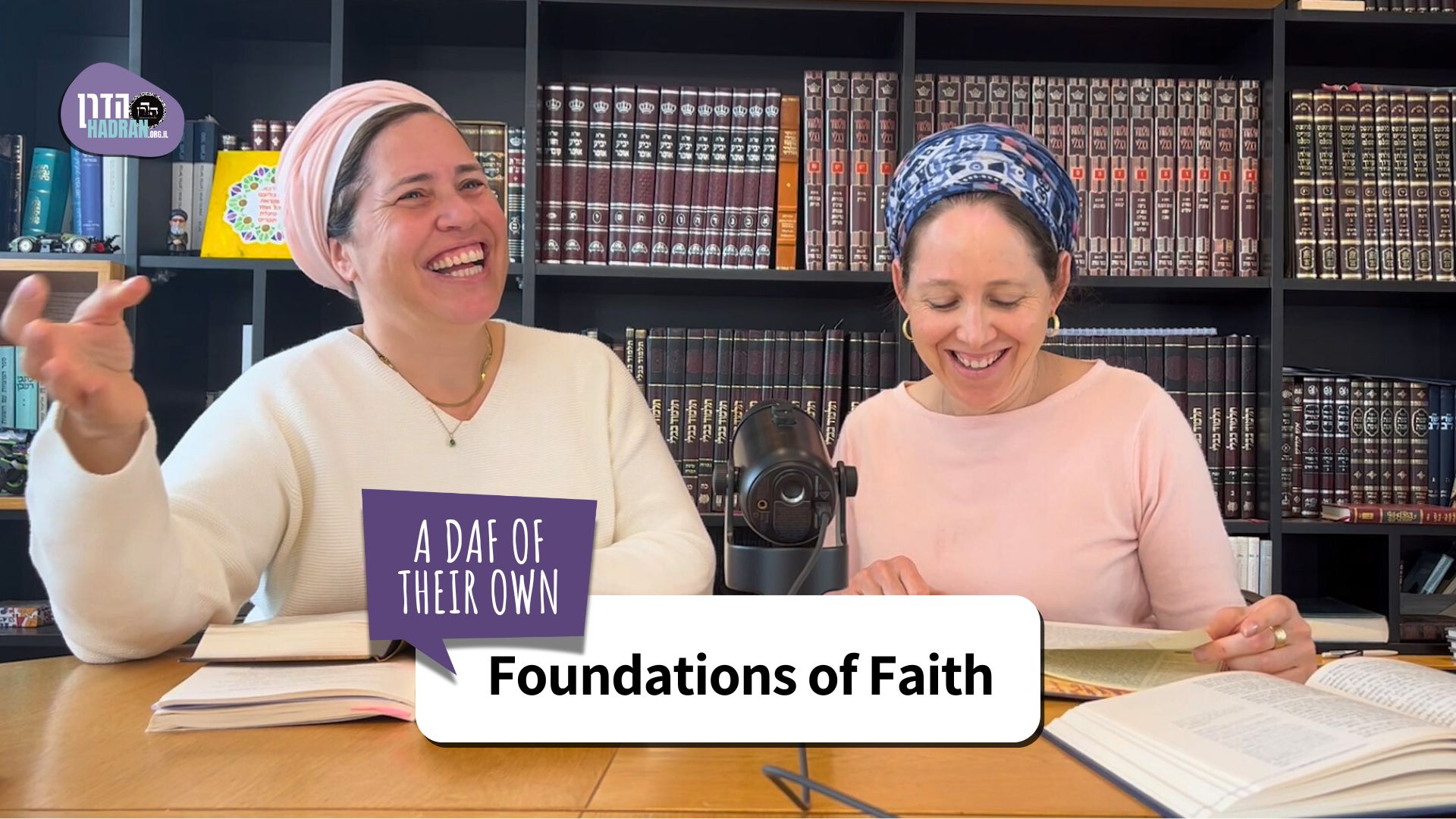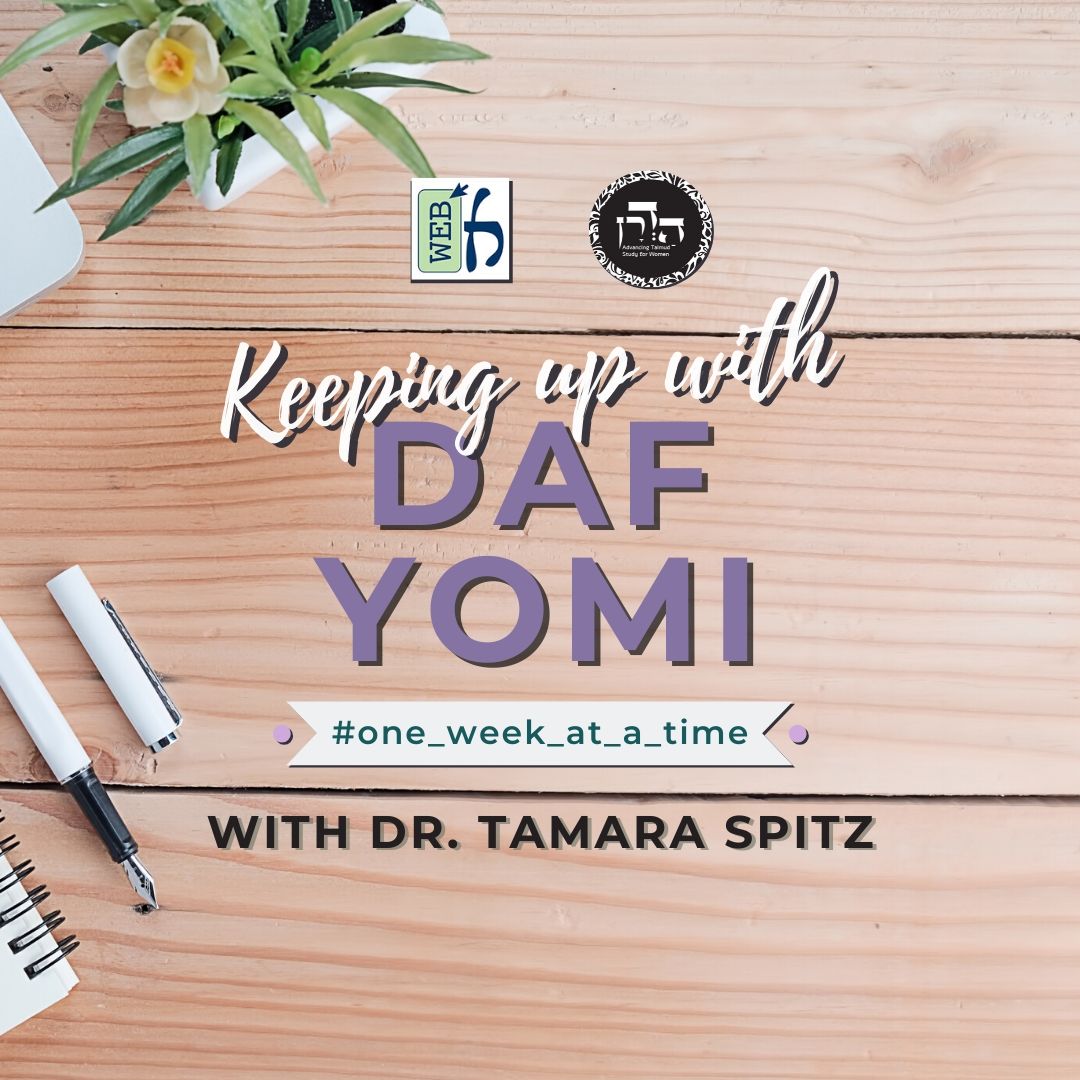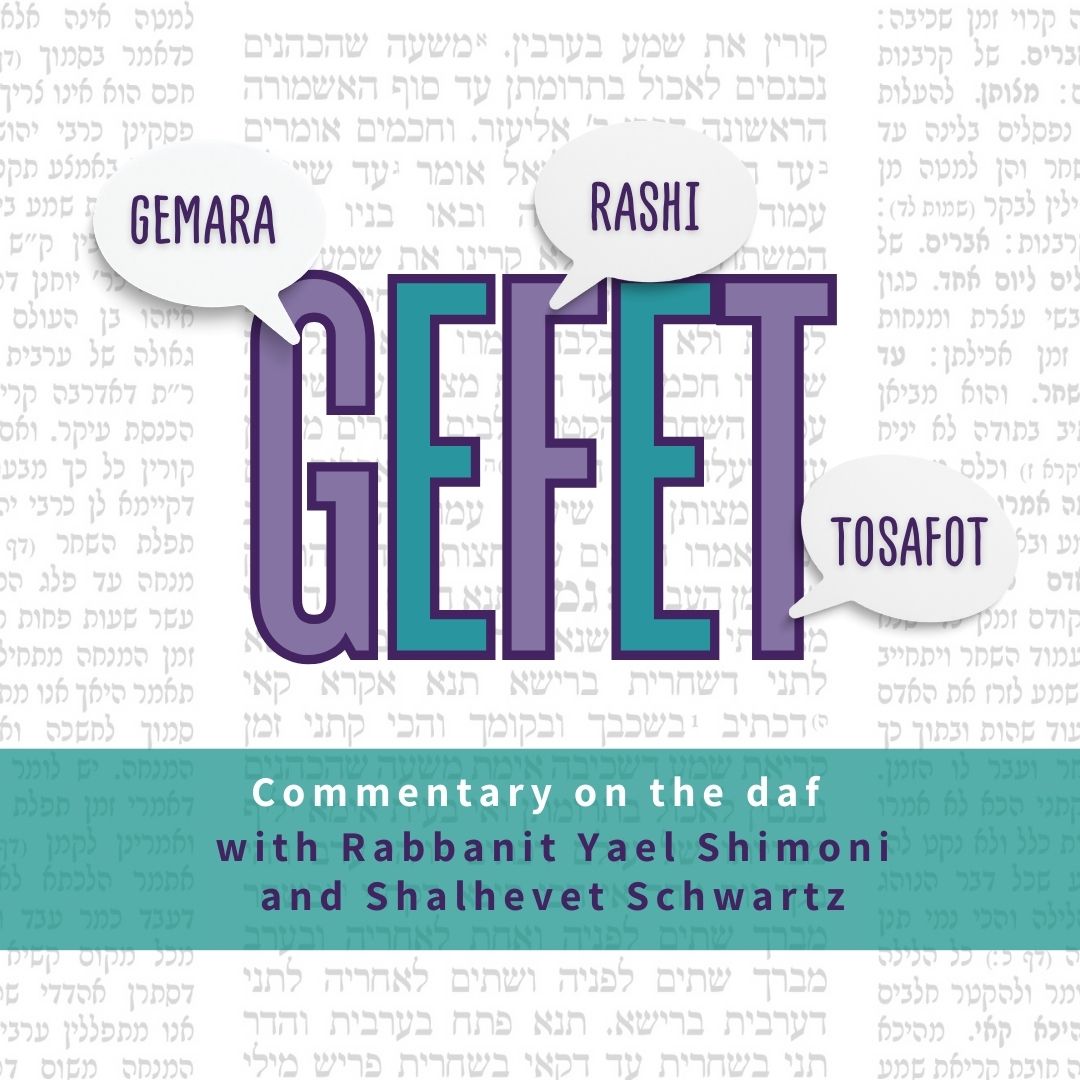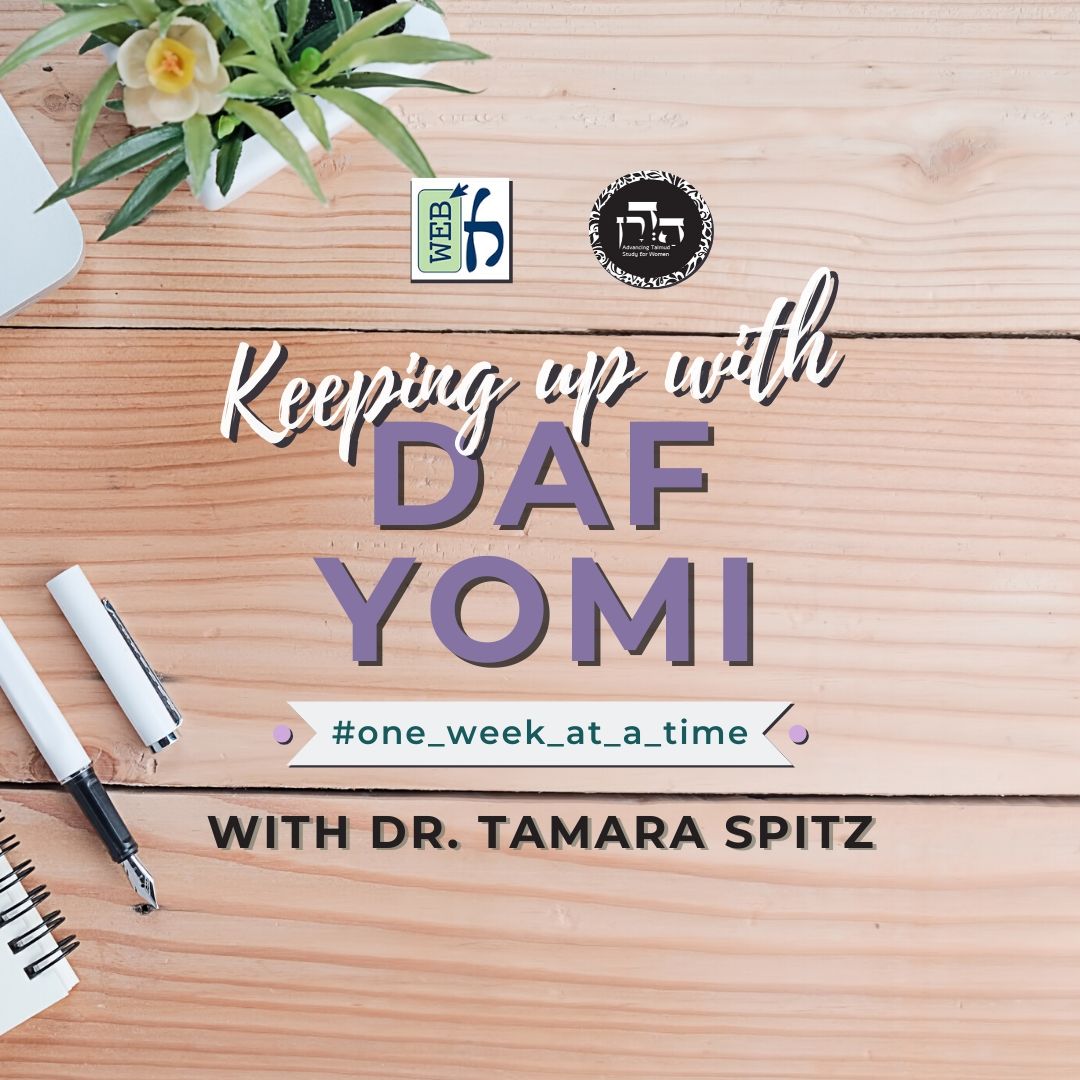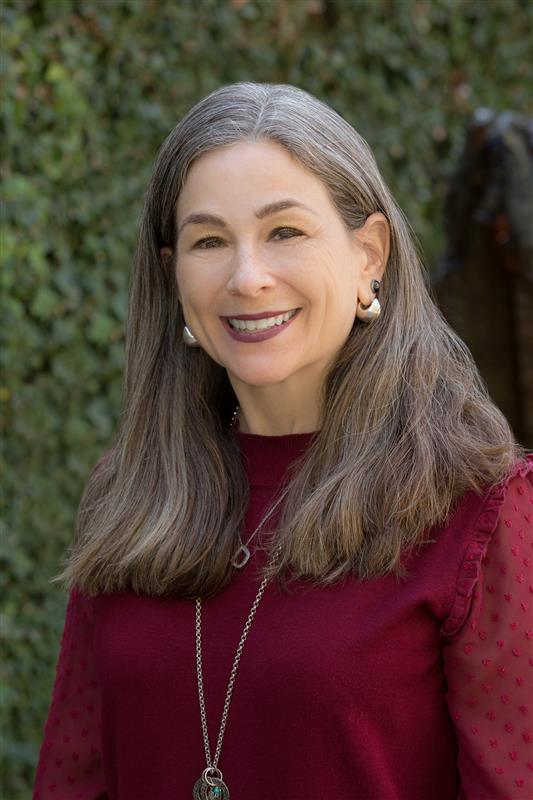Study Guide Menachot 66. Arguments against the Baytusim are brought although Rava rejects many of them. The description of how the meal offering of the Omer was prepared is discussed in more detail.
This week’s learning is sponsored by Caroline Bollag l’ilui nishmat Pinchas ben Menashe Peyser.
Want to dedicate learning? Get started here:

Today’s daily daf tools:
This week’s learning is sponsored by Caroline Bollag l’ilui nishmat Pinchas ben Menashe Peyser.
Today’s daily daf tools:
Delve Deeper
Broaden your understanding of the topics on this daf with classes and podcasts from top women Talmud scholars.
New to Talmud?
Check out our resources designed to help you navigate a page of Talmud – and study at the pace, level and style that fits you.
The Hadran Women’s Tapestry
Meet the diverse women learning Gemara at Hadran and hear their stories.
Menachot 66
הֲרֵי הוּא אוֹמֵר: ״תִּסְפׇּר לָךְ״, סְפִירָה תְּלוּיָה בְּבֵית דִּין, יָצְתָה שַׁבַּת בְּרֵאשִׁית שֶׁסְּפִירָתָהּ בְּכׇל אָדָם.
as the verse states: “Seven weeks you shall number for you; from the time the sickle is first put to the standing grain you shall begin to number seven weeks” (Deuteronomy 16:9). By using the term “for you,” the verse indicates that the counting of the weeks is dependent upon the decision of the court, as they know how to calculate the new months. This serves to exclude the possibility that the counting starts after the Shabbat of Creation, whose counting can be performed by every person, not only the court.
רַבִּי יוֹסֵי אוֹמֵר: ״מִמָּחֳרַת הַשַּׁבָּת״ – מִמָּחֳרַת יוֹם טוֹב. אַתָּה אוֹמֵר מִמָּחֳרַת יוֹם טוֹב, אוֹ אֵינוֹ אֶלָּא מִמָּחֳרַת שַׁבַּת בְּרֵאשִׁית? אָמַרְתָּ: וְכִי נֶאֱמַר ״מִמָּחֳרַת הַשַּׁבָּת שֶׁבְּתוֹךְ הַפֶּסַח״? וַהֲלֹא לֹא נֶאֱמַר אֶלָּא ״מִמָּחֳרַת הַשַּׁבָּת״, דְּכׇל הַשָּׁנָה כּוּלָּהּ מְלֵאָה שַׁבָּתוֹת, צֵא וּבְדוֹק אֵיזוֹ שַׁבָּת.
Rabbi Yosei says that the verse: “And you shall count for you from the morrow after the day of rest [hashabbat]” (Leviticus 23:15), means from the morrow after the festival of Passover. Do you say it means from the morrow after the festival of Passover, or is it only referring to from the morrow after Shabbat of Creation, i.e., Sunday? You can say in response: Is it stated: From the morrow after the day of rest [hashabbat] that is during Passover? No, it is stated only: “From the morrow after the day of rest [hashabbat].” Considering that the entire year is full of Shabbatot, go and try to examine to which Shabbat the verse is referring. How does one know which Shabbat this means? Clearly, then, this “day of rest” is the Festival, not Shabbat.
וְעוֹד, נֶאֶמְרָה ״שַׁבָּת״ לְמַטָּה, וְנֶאֶמְרָה ״שַׁבָּת״ לְמַעְלָה. מָה לְהַלָּן – רֶגֶל וּתְחִילַּת רֶגֶל, אַף כָּאן – רֶגֶל וּתְחִילַּת רֶגֶל.
Rabbi Yosei cites another proof: And furthermore, it is stated “shabbat” below, with regard to the festival of Shavuot (Leviticus 23:16), and it is also stated “shabbat” above (Leviticus 23:15), with regard to starting the counting of the omer. Just as below, with regard to the festival of Shavuot, it is stated: “Even until the morrow after the seventh week [shabbat] you shall number fifty days,” and the word shabbat is referring to a time at the beginning of the Festival; so too here, with regard to the bringing of omer, the word shabbat means Festival, and the counting starts near the beginning of the Festival, on the second day of Passover. According to the Boethusians, sometimes the commencement of the counting is well after the start of Passover.
רַבִּי שִׁמְעוֹן בֶּן אֶלְעָזָר אוֹמֵר: כָּתוּב אֶחָד אוֹמֵר: ״שֵׁשֶׁת יָמִים תֹּאכַל מַצּוֹת״, וְכָתוּב אֶחָד אוֹמֵר: ״שִׁבְעַת יָמִים מַצּוֹת תֹּאכֵלוּ״. הָא כֵּיצַד? מַצָּה שֶׁאִי אַתָּה יָכוֹל לְאוֹכְלָהּ שִׁבְעָה מִן הֶחָדָשׁ – אַתָּה יָכוֹל לְאוֹכְלָהּ שִׁשָּׁה מִן הֶחָדָשׁ.
The baraita continues: Rabbi Shimon ben Elazar says there is yet another proof: One verse states: “Six days you shall eat unleavened bread” (Deuteronomy 16:8), and one verse states: “Seven days you shall eat unleavened bread” (Exodus 12:15). How can these texts be reconciled? Rabbi Shimon ben Elazar explains that there is matza that you are unable to eat for all seven days of Passover, due to the prohibition of harvesting and eating from the new crop of grain that ripened before Passover until after the omer offering. But you are able to eat that same matza for six days, although it is from the new crop, as it is permitted after the bringing of the omer offering on the second day of Passover. This resolution of the verses is possible only if the omer offering is brought on the sixteenth of Nisan, not on any other date.
״מִיּוֹם הֲבִיאֲכֶם … תִּסְפְּרוּ״ – יָכוֹל יִקְצוֹר וְיָבִיא, וְאֵימָתַי שֶׁיִּרְצֶה יִסְפּוֹר?
Rabbi Shimon ben Elazar clarifies another two verses that deal with the counting of the omer: “And you shall count for you from the morrow after the day of rest, from the day that you brought the sheaf [omer] of the waving; seven weeks there shall be complete; even until the morrow after the seventh week you shall number fifty days; and you shall present a new meal offering to the Lord” (Leviticus 23:15–16). One might have thought that although one must harvest and bring the omer meal offering on the second day of Passover, the sixteenth of Nisan, he may start to count the omer from whenever he wishes after that day.
תַּלְמוּד לוֹמַר: ״מֵהָחֵל חֶרְמֵשׁ בַּקָּמָה תָּחֵל לִסְפֹּר״. אִי ״מֵהָחֵל חֶרְמֵשׁ תָּחֵל לִסְפּוֹר״ – יָכוֹל יִקְצוֹר וְיִסְפּוֹר, וְאֵימָתַי שֶׁיִּרְצֶה יָבִיא? תַּלְמוּד לוֹמַר: ״מִיּוֹם הֲבִיאֲכֶם״.
Therefore, the verse states: “Seven weeks you shall number for you; from the time the sickle is first put to the standing grain you shall begin to number seven weeks” (Deuteronomy 16:9). This verse indicates that the counting should commence upon the reaping of the grain for the omer offering. If one would read just this verse: “From the time the sickle is first put to the standing grain you shall begin to number,” one might have thought that one can harvest and count and then bring the omer offering whenever he wishes. Therefore, the other verse states: “From the day that you brought the sheaf of the waving…you shall number fifty days,” indicating that the counting should start on the day the omer offering is brought.
אִי ״מִיּוֹם הֲבִיאֲכֶם״ – יָכוֹל יִקְצוֹר וְיִסְפּוֹר וְיָבִיא בַּיּוֹם? תַּלְמוּד לוֹמַר ״שֶׁבַע שַׁבָּתוֹת תְּמִימֹת תִּהְיֶינָה״. אֵימָתַי אַתָּה מוֹצֵא שֶׁבַע שַׁבָּתוֹת תְּמִימוֹת? בִּזְמַן שֶׁאַתָּה מַתְחִיל לִימְנוֹת מִבָּעֶרֶב.
If one would derive the halakha from this verse: “From the day that you brought the sheaf of the waving,” one might have thought that he should harvest and count and bring the omer offering during the day, not on the night of the sixteenth of Nisan. Therefore, the verse states: “From the day that you brought the sheaf of the waving; seven weeks there shall be complete.” When do you find that there are seven complete weeks? You find it at the time when you begin to count from the evening. Only if the counting commences at night, at the start of the sixteenth of Nisan, will the seven weeks of counting be complete, without missing that first evening.
יָכוֹל יִקְצוֹר וְיָבִיא וְיִסְפּוֹר בַּלַּיְלָה? תַּלְמוּד לוֹמַר ״מִיּוֹם הֲבִיאֲכֶם״, הָא כֵּיצַד? קְצִירָה וּסְפִירָה בַּלַּיְלָה, וַהֲבָאָה בַּיּוֹם.
If so, one might have thought that all of the rites of the omer should be at night, and therefore one should harvest and bring the omer offering and start to count at night. Therefore the verse states: From the day that you brought the sheaf of the waving. How can these texts be reconciled? Does one start at night or in the day? Harvesting and counting should be performed at night, and the bringing of the omer offering is during the day.
אָמַר רָבָא: כּוּלְּהוּ אִית לְהוּ פִּירְכָא, בַּר מִתַּרְתֵּי תַּנָּאֵי בָּתְרָאֵי, בֵּין בְּמַתְנִיתָא קַמַּיְיתָא בֵּין בְּמַתְנִיתָא בָּתְרָיְיתָא, דְּלֵית לְהוּ פִּירְכָא.
§ The Gemara has presented two baraitot with ten proofs between them countering the Boethusian claim that the counting of the omer begins on the Sunday after Passover. Rava said: For all of the suggested proofs there is a possible refutation except for those of the two last tanna’im cited, both in the first baraita and in the second baraita, for which there is no refutation.
אִי מִדְּרַבָּן יוֹחָנָן בֶּן זַכַּאי, דִּלְמָא כִּדְאַבָּיֵי, דְּאָמַר אַבָּיֵי: מִצְוָה לְמִימְנֵי יוֹמֵי, וּמִצְוָה לְמִימְנֵי שָׁבוּעֵי.
Rava elaborates: If one seeks to prove from that which Rabban Yoḥanan ben Zakkai said, that there is a contradiction between two verses, as one indicates that there is an obligation to count fifty days and another that the obligation is to count seven weeks, perhaps this contradiction can be resolved in accordance with the statement of Abaye. As Abaye said: It is a mitzva to count days, and it is also a mitzva to count seven weeks. When one counts, he should track both the number of days and the number of weeks.
אִי מִדְּרַבִּי אֱלִיעֶזֶר וְרַבִּי יְהוֹשֻׁעַ, מִמַּאי דִּבְיוֹם טוֹב רִאשׁוֹן קָאֵי? דִּלְמָא בְּיוֹם טוֹב אַחֲרוֹן קָאֵי!
Rabbi Eliezer derived that the counting is dependent upon the court, not the individual. Therefore, he claimed that when the verse mentions shabbat it must be referring to the Festival, not a regular Shabbat, which does not require a court for its determination. Rabbi Yehoshua derived that just as the counting and sanctifying of the New Moon is performed at a distinct time, so too the counting of the omer and start of Shavuot that follows must occur on a specific date. Rava refutes both of these claims: If the proof is from that which Rabbi Eliezer and Rabbi Yehoshua said, granted that their proofs successfully demonstrate that the counting should start after the Festival, not after Shabbat, but from where does one know that it is referring to the first day of the Festival? Perhaps it is referring to the last day of the Festival, i.e., the seventh day of Passover?
דְּרַבִּי יִשְׁמָעֵאל וְרַבִּי יְהוּדָה בֶּן בְּתֵירָא – לֵית לְהוּ פִּירְכָא.
Rava now addresses the statements of the final two the tanna’im cited in the first baraita: With regard to the proof given by Rabbi Yishmael from the two loaves that are brought at the beginning of a Festival, and the proof mentioned by Rabbi Yehuda ben Beteira from the usage of the word shabbat in connection with Shavuot, Rava said: They have no refutation.
אִי מִדְּרַבִּי יוֹסֵי בְּרַבִּי יְהוּדָה, הֲוָה אָמֵינָא: דִּלְמָא חַמְשִׁין לְבַר מֵהָנֵי שִׁיתָּא.
Continuing with the proofs of the tanna’im from the second baraita, Rava said: If one seeks to disprove the Boethusian claim from that which Rabbi Yosei, son of Rabbi Yehuda, said, that if the counting starts from Shabbat then Shavuot can occur anywhere from fifty to fifty-six days from the date the counting had started the previous year, I would say that perhaps the verse means fifty days excluding these six extra days.
אִי מִדְּרַבִּי יְהוּדָה בֶּן בְּתֵירָא – מִמַּאי דִּבְיוֹם טוֹב רִאשׁוֹן קָאֵי? דִּלְמָא בְּיוֹם טוֹב אַחֲרוֹן קָאֵי!
Rava continues: If one seeks to prove from that which Rabbi Yehuda ben Beteira said in the second baraita, that the verse indicates that the counting is dependent upon the decision of the court, not an individual, this can too be refuted: From where does one know that it is referring to the first day of the Festival? Perhaps it is referring to the last day of the Festival, the seventh day of Passover?
רַבִּי יוֹסֵי נָמֵי חָזֵי לֵיהּ פִּירְכָא, וְהַיְינוּ דְּקָאָמַר ״וְעוֹד״.
Rava concludes: The first proof cited by Rabbi Yosei was that if the counting starts the day after a regular Shabbat then it would be impossible to determine which Shabbat is meant. Rabbi Yosei himself saw that it is also subject to refutation, and this is why Rabbi Yosei continued and said: Furthermore, and suggested a second proof. As Rava declared, the last two proofs cited in the second baraita, the second proof provided by Rabbi Yosei and the proof of Rabbi Shimon ben Elazar, stand without refutation.
גּוּפָא, אָמַר אַבָּיֵי: מִצְוָה לְמִימְנֵי יוֹמֵי, וּמִצְוָה לְמִימְנֵי שָׁבוּעֵי. רַבָּנַן דְּבֵי רַב אָשֵׁי מָנוּ יוֹמֵי וּמָנוּ שָׁבוּעֵי, אַמֵּימָר מָנֵי יוֹמֵי וְלָא מָנֵי שָׁבוּעֵי, אָמַר: זֵכֶר לַמִּקְדָּשׁ הוּא.
§ The Gemara analyzes the matter itself of Abaye’s statement cited in the course of the previous discussion. Abaye said: It is a mitzva to count days, and it is also a mitzva to count weeks. The Gemara notes that in fact the Sages of the study hall of Rav Ashi counted days and they also counted weeks. Ameimar counted days but not weeks. In explanation of his practice, Ameimar said: Since there is no longer an omer offering, the counting is performed only in commemoration of the Temple. Therefore, one does not need to be so scrupulous to count both days and weeks.
מַתְנִי׳ קְצָרוּהוּ וּנְתָנוּהוּ בְּקוּפּוֹת, הֱבִיאוּהוּ לָעֲזָרָה, וְהָיוּ מְהַבְהֲבִין אוֹתוֹ בָּאוּר, כְּדֵי לְקַיֵּים בּוֹ מִצְוַת קָלִי, דִּבְרֵי רַבִּי מֵאִיר. וַחֲכָמִים אוֹמְרִים: בְּקָנִים וּבְקוֹלָחוֹת חוֹבְטִין אוֹתוֹ, כְּדֵי שֶׁלֹּא יִתְמַעֵךְ.
MISHNA: After they harvested the omer and placed it in the baskets, they brought it to the Temple courtyard. And they would singe in the fire the kernels of barley while they were still on the stalks, in order to fulfill the mitzva of parched grain, as it is written: “And if you bring a meal offering of first fruits to the Lord, you shall bring for the meal offering of your first fruits grain in the ear parched with fire” (Leviticus 2:14). This is the statement of Rabbi Meir. And the Rabbis say: Prior to parching the kernels, they would remove them from the stalks by beating them with soft, moist reeds and with cabbage stalks, not with sticks, so that the kernels would not be crushed.
נְתָנוּהוּ לְאַבּוּב, וְאַבּוּב הָיָה מְנוּקָּב, כְּדֵי שֶׁיְּהֵא הָאוּר שׁוֹלֵט בְּכוּלּוֹ. שְׁטָחוּהוּ בָּעֲזָרָה, וְהָרוּחַ מְנַשֶּׁבֶת בּוֹ. נְתָנוּהוּ לְרֵיחַיִם שֶׁל גָּרוֹסוֹת, וְהוֹצִיאוּ מִמֶּנּוּ עִשָּׂרוֹן, שֶׁהוּא מְנוּפֶּה בִּשְׁלֹשׁ עֶשְׂרֵה נָפָה, וְהַשְּׁאָר נִפְדֶּה וְנֶאֱכָל לְכׇל אָדָם, וְחַיָּיב בַּחַלָּה, וּפָטוּר מִן הַמַּעֲשֵׂר. רַבִּי עֲקִיבָא מְחַיֵּיב בַּחַלָּה וּבַמַּעַשְׂרוֹת.
They then placed the grain into a hollow vessel [le’abuv], and this vessel was perforated so that the fire would take hold of the grain in its entirety. After parching the kernels, they would spread the kernels in the Temple courtyard and the wind would blow upon the kernels, cooling and drying them. They then placed the kernels in a mill used to grind grits, so that the barley would not be ground so fine that the shell would be mixed with the grain. And they produced from the ground barley a tenth of an ephah of barley flour that was sifted through thirteen sifters, and the rest is redeemed and may be eaten by any person. And dough from this barley flour is obligated in the separation of ḥalla, and the grain is exempt from the separation of tithe. Rabbi Akiva deems this flour obligated in having ḥalla and tithes separated from it.
גְּמָ׳ תָּנוּ רַבָּנַן: ״אָבִיב״ – זֶה אָבִיב, ״קָלוּי בָּאֵשׁ״ – מְלַמֵּד שֶׁהָיוּ יִשְׂרָאֵל מְהַבְהֲבִין אוֹתוֹ בָּאֵשׁ כְּדֵי לְקַיֵּים בּוֹ מִצְוַת קָלִי, דִּבְרֵי רַבִּי מֵאִיר. וַחֲכָמִים אוֹמְרִים:
GEMARA: The mishna cited a disagreement between Rabbi Meir and the Rabbis as to whether the barley kernels were first singed while they were in their stalks or only after they were beaten and removed from their stalks, when they were placed in a hollow vessel. The Sages taught in a baraita with regard to the verse: “And if you bring a meal offering of first fruits to the Lord, you shall bring for the meal offering of your first fruits grain in the ear parched with fire, even groats of the fresh ear” (Leviticus 2:14). “Grain in the ear”; this is a reference to the grain, i.e., the barley kernel. “Parched [kalui] with fire”; this teaches that the Jewish people would singe it in fire, in order to fulfill the mitzva of bringing parched grain. This is the statement of Rabbi Meir. And the Rabbis say:
אֵין אוּר לְשׁוֹן קָלִי אֶלָּא דָּבָר אַחֵר (הָא כֵּיצַד וְכוּ׳), אֵין לְשׁוֹן קָלִי אֶלָּא דָּבָר (אַחֵר) קָלִיל. הָא כֵּיצַד? אַבּוּב שֶׁל קְלָיוֹת הָיָה שָׁם, וְהָיָה מְנוּקָּב כִּכְבָרָה כְּדֵי שֶׁתְּהֵא הָאוּר שׁוֹלֶטֶת בְּכוּלּוֹ.
Fire is not the proper interpretation of the term kali in the verse. Rather, kali means something else, i.e., the barley was parched inside a receptacle and not directly in the fire. How so? The term kali means only that something else, a vessel made from burnished [kalil] brass was used in the process of parching the grains. How so, i.e., how was this performed? There was a hollow vessel there, in the Temple, which was used for making parched grains. And it was perforated with holes like a sieve, in order to allow the fire to take hold of it in its entirety.
״אָבִיב קָלוּי … גֶּרֶשׂ״, אֵינִי יוֹדֵעַ אִם ״אָבִיב קָלוּי״ אִם ״גֶּרֶשׂ קָלוּי״, כְּשֶׁהוּא אוֹמֵר ״בָּאֵשׁ״ – הִפְסִיק הָעִנְיָן.
The baraita analyzes the verse: “And if you bring a meal offering of first fruits to the Lord, you shall bring for the meal offering of your first fruits grain in the ear parched with fire, even groats of the fresh ear” (Leviticus 2:14). This indicates that the grain used for the omer offering must be parched with fire, but is unclear if that clause modifies the earlier or later part of the verse. In other words, I do not know if grain in the ear is to be parched before it is ground, or if the ground groats are to be parched. The baraita explains that when the verse states: With fire, it interrupted the previous matter and is now introducing a new clause. Accordingly, the instructions to parch with fire is referring to the grain still in the stalks, not the ground groats.
״כַּרְמֶל״ – רַךְ וּמָל, וְכֵן הוּא אוֹמֵר: ״וְאִישׁ בָּא מִבַּעַל שָׁלִשָׁה וַיָּבֵא לְאִישׁ הָאֱלֹהִים לֶחֶם בִּכּוּרִים וְעֶשְׂרִים לֶחֶם שְׂעֹרִים וְכַרְמֶל בְּצִקְלֹנוֹ וַיֹּאמֶר תֵּן לָעָם וְיֹאכֵלוּ״, בָּא וְיָצַק לָנוּ וְאָכַלְנוּ, וְנָוֶה הָיָה.
The verse states that the omer offering should be of the fresh ear [karmel]. The baraita defines karmel as soft and malleable [rakh umal]. And likewise there are other examples of terms that are interpreted as shortened terms, as the verse states: “And there came a man from Baal Shalishah, and brought the man of God bread of the first fruits, twenty loaves of barley, and fresh ears of grain [karmel] in his sack [betziklono]. And he said: Give to the people, that they may eat” (II Kings 4:42). This verse mentions the word karmel in connection with the word betziklono, which is interpreted as an abbreviation for: He came [ba] and he poured for us [veyatzak lanu], and we ate [ve’akhalnu] and it was fine [venaveh haya].
וְאוֹמֵר: ״נִתְעַלְּסָה בָּאֳהָבִים״, נִשֵּׂא וְנִתֵּן, וְנַעֲלֶה, וְנִשְׂמַח וְנִתְחַטֵּא בָּאֳהָבִים.
The baraita presents further examples of words that are interpreted as shortened terms of an expanded phrase. And the verse states: “Come, let us take our fill of love until the morning; let us solace ourselves [nitalesa] with love” (Proverbs 7:18). The word nitalesa is short for: We shall converse [nissa veniten] and we shall go up [vena’aleh] to bed and we shall rejoice [venismaḥ] and be pampered [venitḥata] with loves.
וְאוֹמֵר: ״כְּנַף רְנָנִים נֶעֱלָסָה״, נוֹשֵׂא, עוֹלֶה, וְנִתְחַטֵּא.
The baraita provides an example of a similar shortened word: “The wing of the ostrich beats joyously [ne’elasa]” (Job 39:13). The word ne’elasa is a combination of the words: Carries [noseh], goes up [oleh], and places down [venitḥata]. This bird carries its egg, flies upward, and places it in its nest.
וְאוֹמֵר: ״כִּי יָרַט הַדֶּרֶךְ לְנֶגְדִּי״ – יָרֵאתָה, רָאֲתָה, נָטְתָה.
Likewise, the verse states, after Balaam struck his donkey: “And the angel of the Lord said to him: Why did you hit your donkey these three times? Behold I have come out as an adversary because your way is contrary [yarat] against me” (Numbers 22:32). Yarat is also a shortened term: The donkey feared [yirata], it saw [ra’ata], and it turned aside [nateta].
דְּבֵי רַבִּי יִשְׁמָעֵאל תָּנָא: ״כַּרְמֶל״ – כַּר מָלֵא.
The Gemara returns to discuss the word karmel. The school of Rabbi Yishmael taught that karmel means: A full kernel [kar maleh], i.e., that the shell of the kernel should be filled with the ripened kernel inside.
וְרַבִּי עֲקִיבָא מְחַיֵּיב בַּחַלָּה וּבַמַּעַשְׂרוֹת. אָמַר רַב כָּהֲנָא: אוֹמֵר הָיָה רַבִּי עֲקִיבָא: מֵירוּחַ הֶקְדֵּשׁ אֵינוֹ פּוֹטֵר.
§ The mishna teaches: Rabbi Akiva deems this flour obligated in having ḥalla and the tithes separated from it. Rav Kahana said that Rabbi Akiva would say: The smoothing of a pile of consecrated grains does not exempt it from the obligation to separate tithes if it is later redeemed for common use. This is despite the halakha that the smoothing of the pile is what causes the obligation of separating tithes to take effect.
מֵתִיב רַב שֵׁשֶׁת: מוֹתַר שָׁלֹשׁ סְאִין הַלָּלוּ, מָה הָיוּ עוֹשִׂין בּוֹ? נִפְדֶּה וְנֶאֱכָל לְכׇל אָדָם, וְחַיָּיב בַּחַלָּה, וּפָטוּר מִן הַמַּעַשְׂרוֹת. רַבִּי עֲקִיבָא מְחַיֵּיב בַּחַלָּה וּבַמַּעַשְׂרוֹת. אָמְרוּ לוֹ: פּוֹדֶה מִיַּד גִּזְבָּר יוֹכִיחַ, שֶׁחַיָּיב בַּחַלָּה וּפָטוּר מִן הַמַּעַשְׂרוֹת.
Rav Sheshet raises an objection from a baraita: What would they do with the leftover of these three se’a of barley, i.e., the portion not used for the tenth of an ephah of flour for the omer offering? It is redeemed and eaten by any person, and it is obligated in the separation of ḥalla and exempt from the separation of tithes. Rabbi Akiva deems this flour obligated in having ḥalla and the tithes separated from it. The Rabbis said to Rabbi Akiva: The halakha of one who redeems produce from the possession of the Temple treasurer [gizbar] proves otherwise, as he is obligated in the separation of ḥalla but exempt from the separation of tithes.
וְאִם אִיתָא דְּמֵירוּחַ הֶקְדֵּשׁ אֵינוֹ פּוֹטֵר, מַאי קָאָמְרִי לֵיהּ? הִיא הִיא!
Rav Sheshet explains his objection: And if it is so that Rabbi Akiva holds that smoothing a pile of consecrated grains does not exempt it from tithes, what is the significance of that which the Rabbis said to him? Rabbi Akiva would simply disagree with their premise, as it is the same ruling itself: Just as a pile of consecrated grains that was smoothed is not exempt from tithes, so too, Rabbi Akiva would maintain that produce redeemed from the Temple treasury is not exempt from tithes.
וְעוֹד אֵיתִיבֵיהּ רַב כָּהֲנָא בַּר תַּחְלִיפָא לְרַב כָּהֲנָא (בַּר מַתִּתְיָה): רַבִּי עֲקִיבָא מְחַיֵּיב בַּחַלָּה וּבַמַּעַשְׂרוֹת, לְפִי שֶׁלֹּא נִיתְּנוּ מָעוֹת אֶלָּא לְצוֹרֶךְ לָהֶן.
And furthermore, Rav Kahana bar Taḥlifa raises an objection from a baraita to Rav Kahana bar Matitya, who reported that Rabbi Akiva holds that consecrated grain is not exempt from the obligation to separate tithes. The baraita teaches: Rabbi Akiva obligates one in the separation of ḥalla and in the separation of tithes, as the Temple money designated for the omer crop was given only to cover the cost of that which they required for the offering. Only the requisite tenth of an ephah out of the entire three se’a was paid from the Temple treasury, and was therefore its property. This indicates that had the entire crop been purchased by the Temple, it would be exempt from the obligation to separate tithes.
אֶלָּא אָמַר רַבִּי יוֹחָנָן: תַּלְמוּד עָרוּךְ הוּא בְּפִיו שֶׁל רַבִּי עֲקִיבָא, שֶׁלֹּא נִיתְּנוּ מָעוֹת אֶלָּא לְצוֹרֶךְ לָהֶן.
Rather, Rabbi Yoḥanan says: It is a settled, accepted tradition in the mouth of Rabbi Akiva that the Temple money designated for the omer crop was given only to cover the cost of that which they required for the offering. In other words, Rav Kahana’s version of Rabbi Akiva’s opinion, that in all cases the smoothing of a pile of consecrated grains does not exempt it from tithes, is rejected.
אָמַר רָבָא: פְּשִׁיטָא לִי דְּמֵירוּחַ הֶקְדֵּשׁ פּוֹטֵר, וַאֲפִילּוּ רַבִּי עֲקִיבָא לָא קָא מְחַיֵּיב הָתָם אֶלָּא שֶׁלֹּא נִיתְּנוּ מָעוֹת אֶלָּא לְצוֹרֶךְ לָהֶן, אֲבָל מֵירוּחַ הֶקְדֵּשׁ בְּעָלְמָא פּוֹטֵר.
Rava likewise said: It is obvious to me that the smoothing of a pile of consecrated grain exempts one from any subsequent obligation to separate tithes. And even Rabbi Akiva, who requires the separation of tithes from the remainder of the grain not used for the omer offering, obligates one to separate tithes only there, where the money was given only to pay for that which they required for the offering. But he concedes that the smoothing of a pile of consecrated grain generally exempts one from the obligation to separate tithes.
מֵירוּחַ הַגּוֹי תַּנָּאֵי הִיא, דְּתַנְיָא: תּוֹרְמִין מִשֶּׁל יִשְׂרָאֵל עַל שֶׁל יִשְׂרָאֵל, וּמִשֶּׁל גּוֹיִם עַל שֶׁל גּוֹיִם, וּמִשֶּׁל כּוּתִיִּים עַל שֶׁל כּוּתִיִּים, וּמִשֶּׁל כֹּל עַל שֶׁל כֹּל, דִּבְרֵי רַבִּי מֵאִיר וְרַבִּי יְהוּדָה.
Rava continues: The status of a pile of grain after smoothing performed by a gentile owner is a dispute between tanna’im, as it is taught in a baraita: One separates teruma from produce of a Jew to exempt other produce of a Jew, and from produce bought from gentiles to exempt other produce bought from gentiles, and from produce bought from Samaritans to exempt other produce bought from Samaritans. Furthermore, one may separate teruma from the produce of any of the above to exempt the produce of any of the above. This is the statement of Rabbi Meir and Rabbi Yehuda, as they maintain that produce that belonged to gentiles or Samaritans is obligated in tithes and has the same status as produce that initially belonged to a Jew.
רַבִּי יוֹסֵי וְרַבִּי שִׁמְעוֹן אוֹמְרִים: תּוֹרְמִין מִשֶּׁל יִשְׂרָאֵל עַל שֶׁל יִשְׂרָאֵל, וּמִשֶּׁל גּוֹיִם עַל שֶׁל כּוּתִיִּים, וּמִשֶּׁל כּוּתִיִּים עַל שֶׁל גּוֹיִם, אֲבָל לֹא מִשֶּׁל יִשְׂרָאֵל עַל שֶׁל גּוֹיִם וְשֶׁל כּוּתִיִּים, וְלֹא מִשֶּׁל גּוֹיִם וְשֶׁל כּוּתִיִּים עַל שֶׁל יִשְׂרָאֵל.
Rabbi Yosei and Rabbi Shimon say: One separates teruma from produce of a Jew to exempt other produce of a Jew, and from produce bought from gentiles to exempt produce bought from Samaritans, and from produce bought from Samaritans to exempt produce bought from gentiles. But one may not separate teruma from produce of a Jew to exempt produce bought from gentiles or from Samaritans, nor from produce bought from gentiles or from Samaritans to exempt produce of a Jew. According to Rabbi Yosei and Rabbi Yishmael, produce that belonged to a gentile or a Samaritan is exempt from the obligation to separate tithes. Therefore one may not separate tithes from produce of a Jew, to which the obligation of tithes applies, to exempt such produce.







